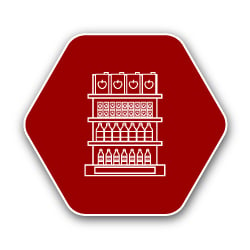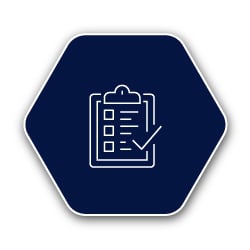Just like anything else in life, if you have a goal, and you are expecting a particular outcome or result, you need to plan. Merchandising is no exception. In fact, we’d argue it’s vital. That’s because while you might get away with an informal plan elsewhere, you can’t expect the same with merchandising.
There are processes and rules to follow. Especially if you want to build an effective planogram that will help you to maximise the sales of your store. It’s for that reason alone that you need to staple down your merchandising principles.
What are merchandising principles?
Before we get into the reasons why you need to decide on your merchandising principles, it’s worth taking a look at the term.
What, precisely, are merchandising principles?
Simply put, your merchandising principles are specific rules to follow to help guide you in placing your products on the shelf in a way that is visually appealing to your customers. The best merchandising tool to present your products is a planogram.
That said, it's critical to note that before you can begin to reference or implement any merchandising principles on a planogram, you first need to understand the category on which you are working. Why? It’s because it’s only once you truly understand your category inside-out that you can be effective in implementing any principles chosen for it.
As for the type of merchandising principles available to you, there are many. There are fixture, general and data-driven space planning principles. One example of a general space planning principle is to face products forward to ensure shelves appear fuller. Another is to merchandise small products on the left and larger products on the right so customers can compare sizes and prices.
We’ll touch on a few more of these principles below in more detail. It’s worth pointing out that you can use them either in isolation or together to meet your category goals and maximise your sales and profit.
Why should you staple down your merchandising principles?
Merchandising principles are the guidelines that you put in place to ensure you build planograms in such a way that you can maximise your sales per square metre or square feet depending on your unit of measure.
As a side note, if you’re a supplier, you should be helping out a retailer with merchandising too. If you don’t, you run the risk of damaging your relationship with them and your products won’t receive appropriate positioning on the shelf.
That aside, as a retailer, there are many reasons why it’s vital for you to staple down your merchandising principles.
1. You can ensure layout consistency across all stores
Your consumer decision tree (CDT), which groups or classifies products according to how your customers shop a category, plays a critical role in how you build your planograms and present your products in-store.
Why?
The better designed your CDT, the easier it is for your space planners to create consistent product layouts across multiple stores. That, in turn, drives customer expectations. A well-designed CDT also allows you to be consistent in the merchandising principles you choose for your category and the products therein.
Let’s say; for example, you’re a retailer who stocks a Baking Aids category and you also have a house brand that you want to sell. For the category, you could set up a rule that states that when a space planner builds a planogram, they must ensure that your store brand sits between the brand leader and the secondary brand leader.
By creating that rule, you make a promise to your customers. By following through on this promise across all your stores - creating store layout consistency - you fulfil that promise.
Here’s another example. You sell Salad Dressings. As a rule, you can state that you should always cross-merchandise these products alongside lettuce in fridges.
Again, by following this rule across all of your stores, you can provide layout consistency. No matter which store a shopper walks into, if they have been to one, they can be rest assured that they’ll know where to find a product in another of your stores.
2. Your shelves will be visually appealing to shoppers
As much as merchandising is about placing the right product in the right spot on the shelf, there is more to it.
By ‘more’, we're referring to the fact that you also need to build planograms that are visually appealing. After all, shoppers buy with their eyes first. If you generate a planogram with visual appeal in mind, you’re thinking about your customers. And you’ll see more success.
There is also the point that a visually appealing store will pull more shoppers into your store.
In the case of generating data-driven planograms (and shelves) that are visually appealing, there are specific rules worth following.
For example, you’d want to consider placing smaller packs above your larger packs and align product heights on the top shelf. That results in a clean and neater display.
On the other hand, you could look at leaving a minimum of 2.5cm (two fingers) between product tops and the shelf above. That allows for a more comfortable shopping experience - customers can take a product off without knocking anything off. Also, it’s pleasing on the eye since the shelf doesn’t appear overcrowded.
3. The flow of your products will make sense to your shoppers
When merchandising your products on a shelf, you need to think about not only how to position them and also where. It's known as your product flow.
As we’ve noted in another article, product flow describes the organised flow of your products in your store, acting as a guide for your shoppers to shop the different categories in your stores.
So how do you create your flow? To get started, you’d ask yourself a series of questions. For example, what essential factors about the category influence how to pack it on the shelf? You also need to look at your merchandising guidelines.
Your merchandising guidelines would include spacing your products out evenly on the shelf, which helps to avoid congestion.
Also, how do you want to present your category? You could choose to merchandise your products from premium to economy or the other way around. You could also look at placing your brand leader at eye-level. Again, whichever guideline you choose, ensure you follow it consistently.
By choosing a logical product flow for each of your categories, any shopper who enters your store can find the products they want quickly and easily. Merchandising coupled with a logical product flow also, more often than not, results in a larger basket size for your customers.
4. You’ll make more sales and generate higher profits
The result of managing your stock and presenting them appropriately on the shelf is that you’ll see more sales and generate higher profits.
That said, you can also follow a few merchandising principles to increase sales and profit over and above that which you earn by following the above rules.
For example, you can make use of days of supply (DOS) to balance out your space to sales ratio. Products with a low DOS are fast movers and sell quickly. In this case, increasing your facings ensures you don’t run into problems such as out of stocks. On the other hand, for slow sellers, you would give them fewer facings so that they don’t sit on your shelf for too long
You could also cross merchandise specific products throughout your store to expose your customers to them. If you get it right, it can result in impulse buys. More than that, you can also merchandise your top sellers at eye-level.
As a side note, a rule such as packing your brand leader at eye-level, which applies to the creation of a product flow works just as well here because you’re positioning a profit generator in the best location on your shelf.
Bonus: It’ll be easier to get sign-off on planograms
As we previously stated, before you can begin building your planograms, it’s critical that you first decide on your merchandising principles. After all, the rules are the foundation and they will guide you on and how and where you place products on your shelf.
There is another reason why it’s critical to decide on your merchandising principles first. It allows for internal alignment around your product layouts, which means its easier to sign-off planograms.
Here’s an example to explain what we mean:
Let’s say a retail buyer decides on the merchandising flow and strategies for their category, which happens to be Baby Foods. They’ll provide all the necessary information to the space planner tasked with building the planogram for the category. They’ll thus know what rules to apply, how many facings to provide to a product and so on.
Throughout the planogram-building process, there should be continuous communication to ensure that everything runs as it should. By doing so, when the time comes for final planogram sign-off, it’s that much easier because everyone involved, from the top to the bottom, knows how the planogram is supposed to look.
Conclusion
DotActiv Lite, Pro, and Enterprise are all different versions of our category management software that allows you to drive category performance. You can book a complimentary consultation with a DotActiv expert here or visit our online store here.


